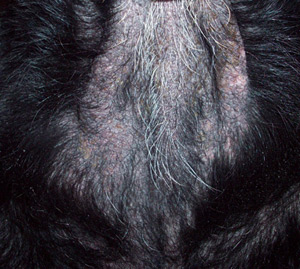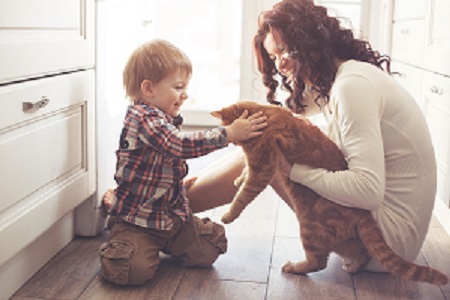- What is allergy?
- Can animals get allergies? If so, how will I know?
- What are some things animals tend to be allergic to?
- How do I know if my pet is itching too much?
- What are “secondary infections”?
- If my pet only seems itchy during a specific time of year, should I be concerned?
- How soon can I expect for my pet’s allergic skin disease to get better?
- What is skin testing?
- Is there a benefit to allergy skin testing?
- What medications need to be discontinued prior to skin testing?
- What medications can I continue to give my pet prior skin testing?
- When is the best time to skin test?
- What is blood (serum) allergy testing?
- How long does it take to see improvement with allergy injections or allergy drops?
- How do I know if my pet has food allergies?
- Can I just treat my pet with steroids?
What is allergy?
Allergy is a hypersensitivity disorder in which the body’s immune system overreacts to normally harmless environmental substances known as allergens. People with allergies usually have symptoms typical of Hay Fever or asthma. Comparatively, small animals usually show signs of allergies on their skin and/or ears. Horses may display signs similar to both people and small animals.
Can animals get allergies? If so, how will I know?
Yes, animals can have allergies just like humans with either seasonal or year-round signs. However, animals typically display signs of allergies on their skin and/or ears. For instance, people with allergies tend to sneeze and wheeze due to allergic rhinitis, sinusitis, and asthma whereas allergic animals tend to itch and scratch due to allergic inflammatory skin and ear disease. In addition to itch, horses may have recurring hives and “heeves/heaves”. As the skin/ears become inflamed, secondary infections (bacteria and yeast) develop leading to an even more heightened state of itch experienced by the pet. Dander (seborrhea), odor, red bumps (papules), pimples (pustules), blackheads (comedones), scabs (crusts), red skin (erythema), skin thickening (lichenification), and hair loss (alopecia) are signs suggestive of allergies complicated by secondary infections.

Hives in the form of ‘rings’ in an allergic horse.
What are some things animals tend to be allergic to?
- Fleas (#1 allergy)
- Food
- Pollen (e.g., tree, grass, weed)
- Molds
- Mites (e.g., house dust and storage mites)
- Insects (a common culprit in horses)
- Dander
How do I know if my pet is itching too much?
Licking, chewing, biting, rubbing, and scratching are all signs of pruritus (itch). Many times animals are itchier during the night when they are not preoccupied with other events. The face, ears, paws, armpits, groin, and rump tend to be the itchiest areas in allergic small animals. Nevertheless, it can be difficult to determine if a cat is itchy or just grooming. If a cat vomits hairballs, has excessive hair in the stool, has areas of hair loss, or has obvious skin lesions, the cat is likely to be itchy. Horses may bite, rub themselves (against stalls, fences, etc.), flick their tail, stomp their feet, and shake their head. The face, ears, mane, underside of the trunk, limbs, and tail base are many times the itchiest areas. Every pet has its own itch tolerance which means the intensity and reason(s) for your pet’s pruritus may not be the same as a friend’s pet.

Itchy allergic skin disease in a cat.
What are “secondary infections?”
Animals with underlying allergies often get secondary problems in the form of infections. Bacteria and yeast (fungus) already normally present on the skin (and in the ear) overgrow and cause infection when the skin (ear) is not properly functioning as is the case with allergies (and a multitude of other underlying skin disorders). Skin inflammation due to allergies favors these infections thereby complicating the clinical picture of the pet. Often these infections add to the overall itch sensation and are responsible for many of the skin changes– dander (seborrhea), odor, red bumps (papules), pimples (pustules), blackheads (comedones), scabs (crusts), red skin (erythema), skin thickening (lichenification), and hair loss (alopecia). Controlling these infections with topical and/or oral antibacterial and antifungal medication along with managing the underlying allergy will help alleviate itch and secondary skin changes. Even the best managed allergic animal will occasionally flare with an infection. Therefore, owners/guardians should routinely look for signs of infection on their allergic pet as infections just add to the animal’s misery.


LEFT: Bacterial skin infection.
RIGHT: Yeast skin infection.
If my pet only seems itchy during a specific time of year, should I be concerned?
It depends. Mild itch that is accepted as tolerable by an owner/guardian may need no therapy other than timely baths. Itch that is more intense or becomes more intense each year warrants a discussion with your primary care veterinarian. Therapy in this circumstance may include flea prevention (fly spray or spot-on for horses), medicated shampoo, antibiotics, anti-yeast medication, antihistamines, a fatty acid supplementation, and/or a short course of oral or topical steroids. If this approach does not help alleviate signs, the pet does not tolerate it, or if the itchy season is lengthening then consultation with a dermatologist is an option. Regardless who examines your pet, it is important to start managing these pets sooner rather than later.
How soon can I expect for my pet’s allergic skin disease to get better?
With dermatology there is no such thing as a “quick fix” because it takes time to understand the underlying cause of your pet’s condition. Often the skin condition has been present for many years prior to referral necessitating an ample period of time to improve and manage skin signs. First, we will need to eliminate the “absolutes” which are infections (bacteria and yeast) and flea/insect bites. Since therapy for allergies is tailored to the individual, other diagnostic tests and therapies are on a case by case basis. It is important to remember that allergies are managed, not necessarily cured!
What is skin testing?
Intradermal testing (IDT) or allergy skin testing is a tool that aids the dermatologist in the selection of environmental allergens (pollen, mold, mites, insects, dander) for subsequent immunotherapy (allergen-specific allergy shots or oral allergy drops). This test followed by tailor-made allergy shots or oral drops is best performed after other possibilities for the itchy skin disease have been excluded. Veterinary IDT is similar to human allergy skin testing; however, our patients need sedation and clipping most of the time. The side of the chest (neck for horses) is shaved in the shape of a rectangle and small black Sharpie pen dots are made in a linear array on the shaved skin allowing the dermatologist to know where to make each injection. A panel of allergens (pollen, mold, mites, insects, dander) is then injected in the skin. The size of any developing wheals is recorded. The entire procedure lasts approximately 30 minutes in small animals, while in horses test reading takes a full 24 hours (overnight stay). Importantly, this test is used for environmental allergies (atopic dermatitis), not food-related allergies.
Is there a benefit to allergy skin testing?
Yes. Intradermal testing allows us to select allergens (pollen, mold, mites, insects, dander) to which the pet is allergic to for immunotherapy (allergy shots or oral allergy drops) administration. These injections or oral drops are the best long-term management strategy for most pets with environmental allergies since they are directed toward improving the underlying cause of signs. Specifically, this form of therapy is designed to de-sensitize your pet’s skin to common every day allergens. However, immunotherapy does not exclude the continued use of topical therapies and routine monthly flea prevention in allergic pets. In general, pets experiencing clinical signs (itchy skin/ears and recurring infections) for at least 5-6 months out of the year benefit the most from this form of testing.
What medications need to be discontinued prior to skin testing?
There are several medications prescribed for itchy skin that will inhibit (wheals) on allergy skin testing. Please keep in mind this is a rough guideline; individual cases may vary. Review the drug withdrawal schedule below and discuss it with your primary care veterinarian. Drugs are to be withdrawn under the advice and discretion of your primary care veterinarian.
| DRUG | WITHDRAWAL TIME |
|---|---|
| Topical steroids (ears, skin, or eyes) | 15-30 days (2-4 weeks) |
| Oral steroids | 30-60 days (4-8 weeks) |
| Injectable steroids | 70-84 days (10-12 weeks) |
| Topical or oral antihistamines | 10-14 days (2 weeks) |
| Fatty acid supplementation (if possible) | 14-21 days (2-3 weeks) |
| Tranquilizers | 2-3 days (0.5 weeks) |
| Cyclosporine | Case by case basis |
What medications can I continue to give my pet prior to skin testing?
Antibiotics, antifungals, flea prevention (fly spray for horses), heartworm prevention, insulin, thyroid supplementation, heart medication, anti-seizure medication, and ophthalmic cyclosporine/tacrolimus for dry eye can be continued prior to any appointment or skin testing procedure. Cool water baths with oatmeal can be used to help soothe the skin and relieve itch up to 3 days before skin testing. Ears may be flushed with a veterinarian-recommended flushing agent. Please discuss what medications you should continue administering prior to the appointment with your primary care veterinarian in the event your pet has not yet been examined by the dermatologist.
When is the best time to skin test?
Skin testing can usually be performed throughout the year; however, pets with seasonal allergies are best tested near the end of their “allergy season” (30-60 days from peak season). Intradermal testing at other times of the year for seasonally allergic pets may require repeat testing. Consequently, many pets will not be skin tested during the initial appointment as the seasonal history needs to be ascertained and complicating infections need to be eliminated.
What is blood (serum) allergy testing?
Blood allergy testing is usually reserved for cases in which skin testing cannot be performed. This scenario occurs when an animal cannot be sedated due to another medical condition or when appropriate drug withdrawal (e.g., steroids) cannot be accomplished. Most dermatologists would agree that intradermal testing (IDT) gives a better reflection of what the skin is reacting to compare to blood allergy testing. Since feline skin does not visibly react as well as other species during (IDT), blood allergy testing may be recommended for allergic cats. Sometimes both tests are used to get a better overall assessment of which environmental allergens are bothersome to the pet. Interpretation of blood allergy tests is improved once other causes of itchy skin disease have been excluded (especially year-round itchy pets). Importantly, this test is used for environmental allergies (atopic dermatitis), not food-related allergies.
How long does it take to see improvement with allergy injections or oral allergy drops?
Most pets will respond to immunotherapy (allergy shots or oral allergy drops) within 6-9 months, but some will require up to a year before total benefits are appreciated. Roughly 50-80% of animals with environmental allergies (atopic dermatitis) respond to this form of therapy, but response does vary. During the initial phase of immunotherapy (“induction”) most pets will require symptomatic treatments (e.g., medicated baths, antihistamines, steroids, cyclosporine) to make them more comfortable. Over time the hope is to reduce the frequency or need of some of these other medications. Please remember allergies are managed and rarely ever cured. Our goal is to reduce 80-90% of the itch/clinical signs, 80-90% of the time.
How do I know if my pet has food allergies?
Animals presenting with itchy allergic skin disease can look very similar if not identical regardless of the “trigger” (pollen, mold, mites, insects, dander, food). This why the animal’s history of itchy skin disease is important as it can provide clues to potential triggers. Animals reacting to foodstuffs tend to have year-round itch assuming they are eating roughly the same diet all year long. Horses with food allergies may have recurring hives as well. In this instance, a veterinarian may recommend an exclusive novel diet (to which the animal has never been exposed) for a period of time in order to determine if food is a component of the signs. If clinical signs improve with the change in diet, then the pet is challenged with the previously fed diet to determine if itch returns. Recurrence of itch after diet challenge confirms the diagnosis of food allergy (cutaneous adverse food reaction). Currently skin testing or blood (serum) allergy testing is not recommended to support a diagnosis of food allergies since these tests have many false results.
Can I just treat my pet with steroids?
Steroids (e.g., prednisone) definitely have their place in the treatment of allergic skin disease, and are often used to alleviate itch. However, long-term use of steroids can cause detrimental health problems. For this reason, it is recommended the underlying trigger of allergic signs be sought and managed with other less harmful treatments for those animals with chronic problems.













